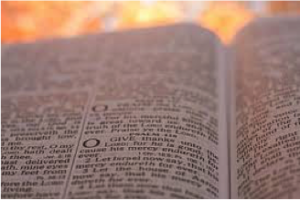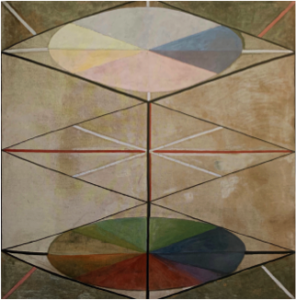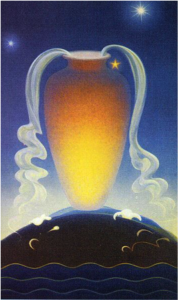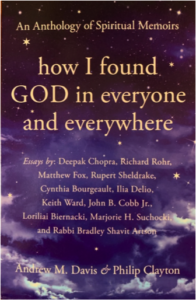This is Part V of an eight-part Northeast Wisdom Home Page Blog series that began on Sunday January 12, 2020, with posts every Sunday and Wednesday during the season of Epiphany. Please share your reflections in the Comments section below. In Parts III and IV, Cynthia introduces us to her own opening through Raimon Panikkar, noting in Part IV his observation that the biggest threat that Jesus represented to the powers that be, was his “filiation” to God —”this unauthorized prophet was standing too close.” Panikkar’s theological vision of a moving, intercirculating, mutually infusing world of worlds, includes us all: we are each and all part of a cosmotheandric universe where, as Cynthia discovers, “God is not a first cause, not an explanation, but rather meaning itself, throbbing through the entire dynamism, suffusing the attuned heart like the air we breathe, like the atoms still reverberating in our bodies from the big bang.”
V. A Brief History of Consciousness  “I solemnly declare that I do believe the Holy Scriptures of the Old and New Testament to be the Word of God and to contain all things necessary to salvation.” It is the occasion of my ordination to the Episcopal priesthood, August 1979, and I am standing before my bishop, making my required public profession. My friends are rolling their eyes, wondering if I’ve just perjured myself. But no, I have never had difficulty with this particular provision, then or now. I do indeed believe that the Holy Scriptures contain all things necessary to salvation.
“I solemnly declare that I do believe the Holy Scriptures of the Old and New Testament to be the Word of God and to contain all things necessary to salvation.” It is the occasion of my ordination to the Episcopal priesthood, August 1979, and I am standing before my bishop, making my required public profession. My friends are rolling their eyes, wondering if I’ve just perjured myself. But no, I have never had difficulty with this particular provision, then or now. I do indeed believe that the Holy Scriptures contain all things necessary to salvation.  So does a rock. So does this ten-foot-wide patch of ocean I am now sailing through after the fog has shut down my usual visual horizons. So does almost anything in this holy, God-infused universe of ours when we truly open our hearts to it. But scripture is indeed its own unique brand of wonderfulness, and over the nearly seven decades it’s been part of my life, I have come to appreciate its sacredness in a whole different way. Back then I looked upon it as the unchanging revelation of the one true God. Now I look at it as an extraordinary, sacred archive of the evolution of human consciousness. The idea of levels of consciousness, first advanced in the late1940s by Jean Gebser and Ernst Neumann and carried forward into our own times primarily through the work of Ken Wilber, suggests (in a nutshell) that each of us in the course of our lives pass through a series of levels of consciousness. Beginning in the undifferentiated “uroboric” state of infancy, we pass through the magical consciousness of early childhood, where the world is alive with “ghoulies and ghosties, long-leggity beasties, and things that go bump in the night;” to mythic membership (identification with the group or tribe); rational; pluralistic (“Co-exist!”)—and finally, if we’re lucky, to those “nondual” states of integral and cosmic consciousness, where we begin to see all things from the perspective of oneness. In the same way that an individual progresses through these levels in the course of life, moving as far as he or she is able to along the gradient, so our entire human family has passed through these same stages, “writ large” in the history of civilization.
So does a rock. So does this ten-foot-wide patch of ocean I am now sailing through after the fog has shut down my usual visual horizons. So does almost anything in this holy, God-infused universe of ours when we truly open our hearts to it. But scripture is indeed its own unique brand of wonderfulness, and over the nearly seven decades it’s been part of my life, I have come to appreciate its sacredness in a whole different way. Back then I looked upon it as the unchanging revelation of the one true God. Now I look at it as an extraordinary, sacred archive of the evolution of human consciousness. The idea of levels of consciousness, first advanced in the late1940s by Jean Gebser and Ernst Neumann and carried forward into our own times primarily through the work of Ken Wilber, suggests (in a nutshell) that each of us in the course of our lives pass through a series of levels of consciousness. Beginning in the undifferentiated “uroboric” state of infancy, we pass through the magical consciousness of early childhood, where the world is alive with “ghoulies and ghosties, long-leggity beasties, and things that go bump in the night;” to mythic membership (identification with the group or tribe); rational; pluralistic (“Co-exist!”)—and finally, if we’re lucky, to those “nondual” states of integral and cosmic consciousness, where we begin to see all things from the perspective of oneness. In the same way that an individual progresses through these levels in the course of life, moving as far as he or she is able to along the gradient, so our entire human family has passed through these same stages, “writ large” in the history of civilization.

Seen in this way, the people of Israel are indeed, quintessentially, “the pen that God writes with” (as our Israeli tour guide categorically proclaimed during my first pilgrimage to the Holy Land). The journey we call the Old Testament really gets underway around the shift from magical consciousness to mythic membership consciousness. That’s what I was really witnessing in all those Bible stories of my childhood, those holy wars on “idol worship.” What I now know from a wider reading of human anthropology is that all those struggles with the Canaanites and Baal worshippers were really playing out the displacement of an earlier, magical consciousness in the transition to the next level, mythic membership. Israel swept like a holy dust storm into these ancient matriarchal lands, replacing the gods of rocks and rivers with a new concept, of a God “out there,” related to creation through covenant, not indwelling. It was a clear and significant evolutionary leap. The twelve tribes of Israel came into being as the active agency of this transition, determinedly obliterating their neighbors and even earlier, “pagan” vestiges in their own tradition to clear the way for this heretofore unconceivable new beachhead of divine/human consciousness.

Then, beginning in the Davidic psalms and continuing in earnest through the post-exilic prophets, we see the rise of rational consciousness as across the entire planet the winds of that great “first axial” age begin to blow and Israel awakens to the idea of a personal relationship and individual accountability with this great transcendent Yahweh. Finally, in those mysterious apocalyptic images of the “suffering servant” and that elusive “son of man,” we see the first intimations of a whole new level of consciousness, integral verging toward nondual: the capacity to think from the whole, not from the part, and thus for the first time in the history of civilization to begin to envision the possibility of a collective humanity. This is where Jesus takes up the story. As far as the West is concerned, he is indisputably the first to model a fully attained nondual consciousness: flowing, compassionate, holographic, unbound by the conventions of those lower orders of consciousness which require that things be separated from each other in order to make sense of them. He is literally envisioning a new world, based on a new mode of consciousness: unity attained. And of course, the planet was not ready for him then—and is still barely ready.
Look for Cynthia’s next post in this series, “I Am Not a Space that God Does Not Occupy: Part VI: A Brief History of Consciousness, Continued” Wednesday January 29, 2020 here on the Northeast Wisdom Home Page Blog. You may click on these links to go to “Part I: The Light Within,” “Part II: Panenthesim,” ” Part III: Panikkar,” and “Part IV: Jesus Was Not a Monotheist(!?)“ From My Introduction to This Series:
“May this “year of perfect vision” indeed shed some new light.
 “Dear Wisdom Friends, As the new decade gets underway, it feels like an appropriate moment to share one of my earlier essays, which is still to my mind one of the best things I’ve ever written. It was originally published in the 2018 anthology, how I found GOD in everyone and everywhere… Enjoy! And Happy New Year!!!
“Dear Wisdom Friends, As the new decade gets underway, it feels like an appropriate moment to share one of my earlier essays, which is still to my mind one of the best things I’ve ever written. It was originally published in the 2018 anthology, how I found GOD in everyone and everywhere… Enjoy! And Happy New Year!!!
“how I found GOD in everyone and everywhere is an anthology of spiritual memoirs, edited by Claremont School of Theology faculty members Andrew M. Davis and Philip Clayton and published by Monkfish, our intrepid publishing partner here in Northeast Wisdomland! Compiled in honor of Marcus Borg, this anthology is broadly structured around the theme of Panentheism and features the usual suspects among Christian nondual teachers, including my colleagues Richard Rohr, Matthew Fox, and Ilia Delio. It’s well worth a read in its entirety.”
~Cynthia Bourgeault, January 2020 We look forward to the conversation continuing in Comments!



Klint has been on my mind constantly (her third altarpiece as a visual of the relationship between developmental stages and gebser’s structures) since starting Jeremy Johnson’s most recent course. Decided to see if Klint and Gebser had any contact or communication with each other, and I love that your site came up first. I’ve been a huge fan for years.
The analogy I’ve been using is of a wise old priest communing with a young acolyte. The acolyte sees layers of growth between themselves and the priest The priest’s wisdom is that she simultaneously sees them both as just two children sitting on a bench and is also able to hold and respect the layers that, for the acolyte, are necessary to organize consciousness or their journey.
Jesus apparently is the first in the West who is known to have fully attained nondual consciousness. Many in the East attained nondual consciousness even long before Jesus. It is ironic that the Western institution that developed in Jesus’ name, that is, Christianity, supposedly worships Jesus while being ignorant of the nondual consciousness he attained and pointed to, and there are people and institutions of the East that don’t worship Jesus but do embrace the nondual consciousness that he attained.
As I read your post on “Consciousness” I was reminded of a book that put words to my struggling faith years ago called:
The Critical Journey: Stages in the Life of Faith by Janet Hagberg. Perhaps it could even have been called Stages in the Life of Consciousness.
In it she shares the six stages of faith with hitting the wall slicing between stage 4 and stage 5
Stage 1: The recognition of God
Stage 2. The life of discipleship
Stage 3. The productive life
Stage 4. The journey inward
The wall
Stage 5. The journey outward
Stage 6. The life of love
I remember being in stages 1 2 and 3 with the certainty of my beliefs, belonging to my tribe and seeking to live it out by sharing how others could join my tribe. When I hit the wall in my life – suffering through an identity crisis as well as opening my heart to past childhood trauma my clear and dogmatic beliefs began to shift and evolve. God began to crack open my heart center. As I was moving on my journey and gradually Awakening to new depths and heights it was not necessarily welcome by my tribe as they saw me potentially falling from grace. The church is a big tent but in the Evangelical tradition where I spent a good many years I would say most of these churches are best at working with people in stages 1 through 3 because as an organization they have not gone beyond stage 3. So when individuals move beyond stage 3 and begin to question and doubt and struggle it can cause ripples in both an individual’s life as well as the church’s life.
As consciousness grows and expands upon our planet my prayer is that God will raise up new forms, organizations, and structures that can hold this expanding consciousness. I believe your work Cynthia is one such model with the Wisdom Schools and I rejoice in it!